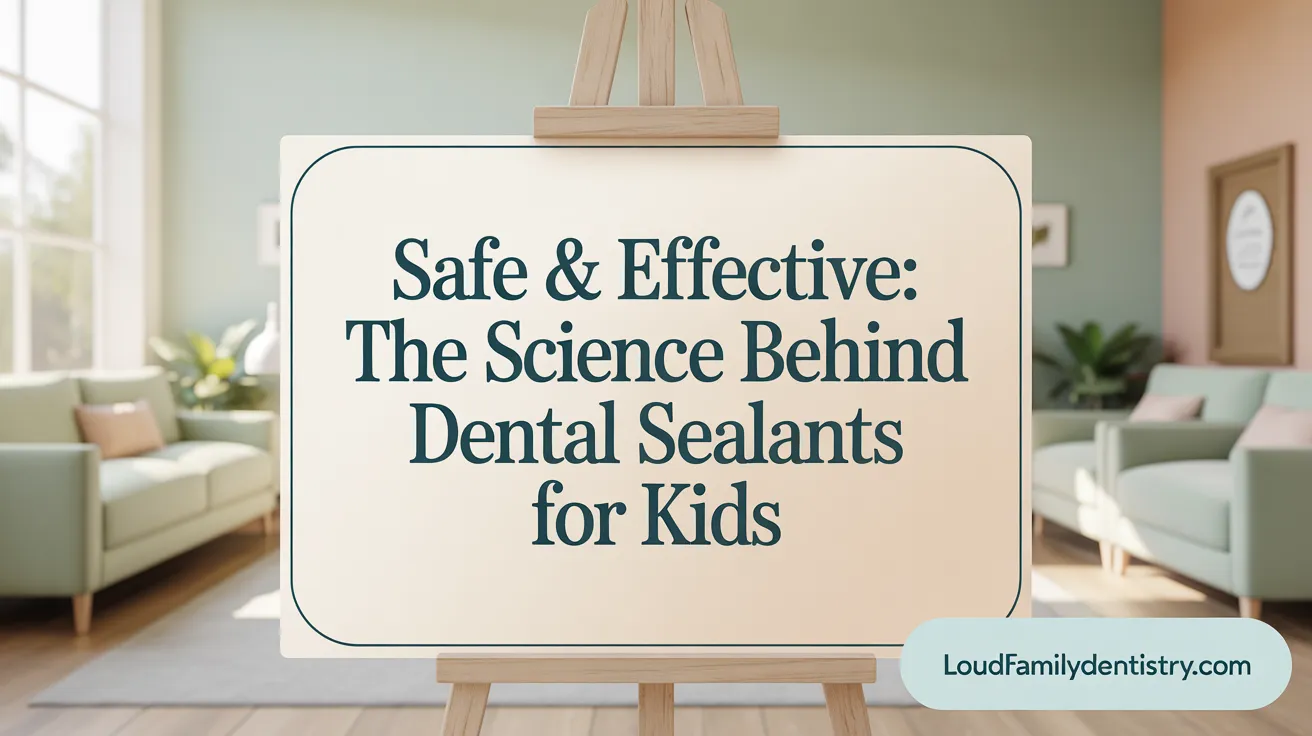Understanding Dental Sealants and Their Importance
Dental sealants are a key preventive measure in children's dentistry that effectively protect teeth from decay. Acting as thin, protective barriers on the chewing surfaces of back teeth, sealants prevent cavities by blocking out harmful bacteria and food debris. This article explores how sealants work, their application process, benefits, safety, and their pivotal role in maintaining children's oral health.
The Protective Role of Dental Sealants in Children's Oral Health

What are dental sealants?
Dental sealants are thin coatings made from plastic or glass ionomer materials that are applied to the chewing surfaces of back teeth, mainly molars and premolars. These coats bond to the enamel and create a hard barrier that helps shield teeth from decay. Typically, they are clear or slightly tinted, making them virtually invisible when a child smiles or talks.
How do sealants function as protective barriers?
Sealants serve as a physical shield over the deep pits, grooves, and fissures of molars, locations where food particles and bacteria tend to become trapped. By sealing these hidden areas, they prevent plaque buildup, bacteria, and food debris from settling onto the tooth surface. This barrier significantly reduces the likelihood of cavity formation, especially in areas that are hard to clean through brushing alone.
Why are they important in preventive dentistry?
Applying sealants is a highly effective preventive measure. Studies show that they can prevent up to 80% of cavities in molars during the first two years of application. Children and teenagers, in particular, benefit from this easy and painless procedure, which complements good oral hygiene practices, fluoride use, and regular dental checkups. Sealants help establish a foundation for lifelong dental health by protecting young teeth before decay begins.
When should sealants be applied?
The ideal timing for applying sealants is soon after the eruption of permanent molars, generally between ages 6 and 12. The first molars typically come in around age 6, with the second molars appearing at age 12. Children with deep grooves in primary (baby) teeth may also receive sealants to prevent early decay. Early application ensures maximum protection during years when children are most prone to cavities.
How long do sealants last?
Sealants typically provide protection for five to ten years. Their longevity depends on factors such as chewing habits, oral hygiene, and the quality of application. They gradually wear down or chip over time but can be inspected, repaired, or reapplied during routine dental visits to maintain their protective effect.
Ongoing care and monitoring
Regular dental check-ups are essential for monitoring the condition of sealants. Dentists will inspect the sealed surfaces, clean them if necessary, and reapply or repair sealants that have worn away or become damaged. Good oral hygiene habits, including brushing, flossing, avoiding sticky or hard foods, and using fluoride toothpaste, further help preserve the effectiveness of sealants. This comprehensive approach ensures sustained protection against cavities and promotes overall oral health in children.
How Dental Sealants Effectively Prevent Tooth Decay in Children

How do dental sealants prevent tooth decay in children?
Dental sealants are thin, plastic coatings applied to the chewing surfaces of back teeth, specifically molars and premolars. Their primary function is to act as a physical barrier, sealing deep pits and grooves where food particles, bacteria, and plaque often become trapped and difficult to clean. This barrier prevents harmful bacteria from developing in these hard-to-reach areas, reducing acid production by bacteria that cause cavities.
The application process is simple, quick, and painless, involving cleaning the tooth, etching its surface with a gel to help the sealant bond, then applying the resin material, which is cured with a special light. Once sealed, the fluoride-containing material bonds directly to the enamel, reinforcing the tooth and extending its resistance to decay.
Sealants are especially beneficial for children, as they can be applied as soon as permanent molars first come in—usually around ages 6 and 12. They have proven to significantly cut the risk of cavities, with studies showing they can prevent up to 80% of decay in molars within the first two years after application. This preventive measure not only preserves children’s oral health but also reduces the need for more invasive dental treatments later on.
Overall, dental sealants provide an effective, low-cost way to shield young teeth from the development of cavities, especially when combined with good oral hygiene practices and regular dental visits.
A Step-by-Step Guide to the Application Process of Dental Sealants
What is the process of applying dental sealants on children's teeth?
Applying dental sealants to children's teeth is a fast, painless procedure performed by a dental professional. It involves several straightforward steps designed to create a protective barrier against cavities.
First, the dentist or hygienist begins by thoroughly cleaning the tooth surface to remove any food debris, plaque, or bacteria. This ensures that the sealant adheres properly to the enamel.
Next, the tooth is isolated to keep it dry during the procedure. Usually, rubber dam techniques, cotton rolls, or other isolating methods are used to prevent saliva from contaminating the tooth.
Once the tooth is dry, a special gel called etchant, typically containing acid, is applied to the chewing surfaces for about 15–20 seconds. This roughens the enamel surface, helping the sealant bond securely.
After etching, the gel is rinsed off thoroughly, and the tooth is dried until it appears frosty and chalky—an indication it’s ready for sealant application.
The next step involves painting a liquid resin or plastic material over the fissures and pits on the tooth. The sealant flows into these deep grooves, sealing them shut.
Finally, a curing light—usually a blue or ultraviolet LED— is used to harden the sealant quickly. This process typically takes around a minute per tooth.
The entire procedure is quick, often completed within five to ten minutes per tooth. Children can immediately return to normal eating and drinking without any restrictions, making sealants a convenient and effective preventive treatment.
Benefits and Longevity of Dental Sealants in Preventing Cavities

What are the benefits of dental sealants in preventing cavities in children?
Dental sealants act as a protective barrier on the chewing surfaces of molars and premolars, which are the most prone to cavities due to deep pits and grooves. They effectively prevent bacteria, food particles, and plaque from settling into these difficult-to-clean areas. This sealing action significantly lowers the risk of developing tooth decay, particularly soon after the eruption of permanent teeth when children are at higher risk. The application process is simple, quick, and painless, involving cleaning the teeth, applying an acid gel to help bond the sealant, and then using a curing light to harden the material. Sealants are especially effective in children because they target the hard-to-reach areas of newly erupted teeth, helping to maintain long-term oral health. Research from the American Dental Association suggests that sealants can prevent up to 80% of cavities for at least two years after application, with ongoing protection lasting up to four to ten years with regular dental check-ups and maintenance. Since sealants reduce the likelihood of future dental issues, they are a cost-effective preventive measure that can diminish the need for invasive and expensive treatments later in life. Overall, dental sealants provide an accessible, safe, and highly effective method to safeguard children's teeth from decay, promoting healthier smiles and reducing dental treatment burdens.
Safety and Effectiveness of Dental Sealants for Children

Are dental sealants safe and effective for children?
Dental sealants are widely regarded as a safe and effective way to protect children’s teeth from cavities, especially in the tough-to-clean pits and fissures of molars and premolars. Supported by numerous dental associations, including the American Dental Association (ADA) and the CDC, sealants are proven to significantly reduce decay risk in children's teeth.
The application process is simple, quick, and pain-free, involving cleaning the tooth, applying an acid etchant to create a rough surface, and then bonding the sealant material, which hardens with a curing light. Most sealants are made from resin-based materials or glass ionomers, which bond securely to enamel and form a durable protective barrier.
Concerns about BPA (Bisphenol A), a chemical previously found in some sealant materials, have been carefully addressed by manufacturers. Modern sealants are now either BPA-free or contain only minimal, safely leached amounts of BPA, which research indicates pose little to no health risk to children.
Long-term safety data further reinforce the trust in dental sealants. Studies spanning decades show that when applied correctly and maintained with regular dental check-ups, sealants remain safe and effective for many years, often lasting between five and ten years.
Overall, sealants provide a significant benefit by reducing cavity risk by nearly 80% in the first two years and continuing to offer protection for several years afterward. When combined with good oral hygiene and fluoride use, they are a cornerstone in preventive pediatric dental care.
Educational Insights: Why Sealants Are Critical in Children's Oral Care

Why are molars and premolars with deep grooves particularly important?
Deep grooves and pits on molars and premolars create natural traps where food particles and bacteria can easily accumulate. These areas are tricky to clean thoroughly, making them highly susceptible to cavities. Protecting these teeth with sealants provides a smooth, protective barrier that prevents decay in these vulnerable spots.
What are the challenges in children's oral hygiene?
Children often face difficulties maintaining thorough oral hygiene due to the complexity of cleaning deep grooves and their developing brushing skills. Additionally, many children consume sugary and sticky foods that stick to teeth, increasing cavity risks. These factors make it harder for children to stay cavity-free with good brushing alone.
How do sealants serve as an extra layer of protection?
Sealants act as a physical shield, filling in the deep pits and fissures of molars and premolars. This prevents food, plaque, and bacteria from settling into these hard-to-clean areas. Studies show that sealants can reduce cavity development in molars by up to 80% within the first two years and continue to offer protection for several years afterward.
When do pediatric dental authorities recommend applying sealants?
Pediatric dental organizations, including the American Dental Association and the American Academy of Pediatric Dentistry, recommend applying sealants as soon as the permanent molars and premolars erupt. The ideal timing is around ages 6-7 for the first molars and 11-14 for the second molars. Early application ensures maximum protection during the cavity-prone years.
How do sealants contribute to reducing dental health disparities?
Sealant programs in schools are especially effective in reaching children from lower-income communities who may lack access to regular dental care. By providing preventive treatment early, these programs help reduce the incidence of cavities and promote equitable dental health across different socioeconomic groups.
Why is combining sealants with good oral hygiene important?
While sealants significantly lower cavity risk, they do not replace daily brushing, flossing, and fluoride use. Proper oral hygiene is essential in maintaining overall dental health and prolonging the effectiveness of the sealants. Regular dental check-ups ensure the sealants are intact and functioning properly.
| Key Aspect | Details | Additional Information |
|---|---|---|
| Application age | 6-7 years and 11-14 years | Critical periods for protection |
| Benefits | Up to 80% cavity reduction in 2 years | Long-lasting protection |
| Material | Resin, BPA-free, fluoride options | Safe and effective |
| Duration | 5-10 years | Regular checkups needed |
| Complementary practices | Fluoride, hygiene, healthy diet | Maximize dental health |
Conclusion: Empowering Children’s Oral Health with Sealants
Dental sealants stand out as an essential preventive tool in protecting children’s teeth from decay by sealing vulnerable grooves and fissures on molars and premolars. Their proven effectiveness, durability, safety, and painless application make them a highly recommended choice among dental professionals for children’s oral health. Sealants not only prevent cavities but also complement good dental hygiene practices, creating a comprehensive defense against tooth decay. By ensuring timely application, regular dental visits, and proper care, parents can help their children enjoy healthier smiles and avoid painful, costly dental treatments in the future.
References
- About Dental Sealants | Oral Health - CDC
- Dental Sealants: How They Work - Cleveland Clinic
- Dental Sealants: Protecting Your Children's Teeth
- Why Dental Sealants Play an Important Part in Protecting Your ...
- A Parent's Guide to Dental Sealants for Kids in North Dallas
- Why Choose Dental Sealants in Jacksonville Beach for Your Child?
- Dental Sealants Prevent Cavities in Children - Plano & Carrollton
- Dental sealants can protect your children's teeth
